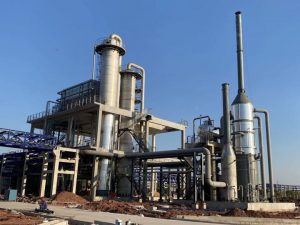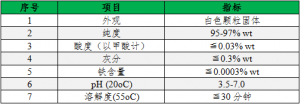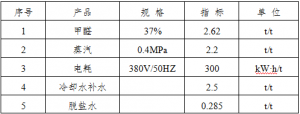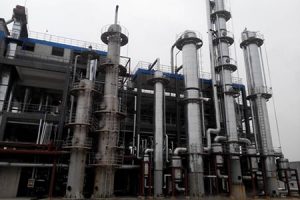- Production ProcessAs the pioneer of domestic spray granulation paraformaldehyde technology, the Huda Chemical Team successfully engineered the technology in 2014, breaking the foreign monopoly on my country’s paraformaldehyde technology and pioneering the clean production process of paraformaldehyde in my country. .
There are currently many engineering cases at home and abroad.

(The picture shows the Anhui project site)
Compared with the traditional rake drying process, our spray granulation process has the following advantages:
The product has high purity, good porosity, good water solubility, depolymerization time period, continuous production, large single-line production capacity, and greatly improved production environment.
Jiangsu Huda Chemical Technology Co., Ltd. has long-term provided 10,000-60,000 tons of spray granulation paraformaldehyde equipment. Customers are welcome to inquire. - Performance parametersproduct quality
92% paraformaldehyde

96% paraformaldehyde

consumption quota

Spray granulation paraformaldehyde consumption table (based on 92% paraformaldehyde per ton produced)
Process flow diagram

(Paraformaldehyde production technology (spray granulation method))
Technical advantages
- With many years of experience in formaldehyde and downstream product technology research and development, production and operation, our company has mature and reliable paraformaldehyde complete production technology. This technology uses spray drying technology and has the following technical advantages:1) Using two-level concentration and advanced drying technology, the product quality is good and the cost is low;
2) Have extensive design and operation experience in the design of spray towers and nozzles and the selection of catalysts;
3) It can co-produce methylal and other products, with high comprehensive utilization rate of heat and strong market competitiveness.
-
crafting process
- The evaporation and concentration evaporation part of formaldehyde solution
includes a falling film evaporator and a thin film evaporator. This system brings together many years of practical experience. When the material passes through the heating zone, the residence time is very short, the thermal conversion efficiency of the evaporator is very high, and the product is efficiently concentrated under mild conditions; 2. The
spray freezing and fluidized bed drying
solidification and drying part consists of a spray freezing tower and a Fluidized bed dryer, forming a two-step flexible freeze-drying system. First, the concentrated formaldehyde is freeze-dried in the spray freezer to evaporate the surface water in the product, and then the remaining small amount of water is evaporated again in the fluidized bed dryer; 3. Exhaust gas absorption Part of the exhaust gas comes from the spray freezing
system
. This part of the exhaust gas can be processed through the internal gas purification system. In addition to a small amount of purge gas, a large amount of gas is used for internal circulation (closed nitrogen circulation system). In order to control the oxygen content in the circulating gas and keep it below the explosive value, a small amount of purge gas needs to be maintained. The gas needs to pass through the gas scrubber and be discharged after being qualified. Another part of the exhaust gas, such as from the vacuum evaporation system, storage and packaging process, is also discharged after passing through the gas scrubber.
4. Formaldehyde solution
During the production process of paraformaldehyde, a part of dilute formaldehyde solution will be produced in the evaporation section. These dilute solutions are returned to the system and used to prepare 37% formaldehyde solution for export, or to produce methenamine and methylmethacrylate. Aldehydes and other downstream products.
- The evaporation and concentration evaporation part of formaldehyde solution
- Technology Introduction
Paraformaldehyde with a low degree of polymerization has a higher content of active ingredients than industrial formaldehyde, and is in the form of solid particles, making it easy to store and transport. It is beneficial to applications in chemical synthesis, pharmaceuticals, and other industrial fields, especially when anhydrous formaldehyde is used as raw material. When synthesized, it has a wide range of uses.
The uses of paraformaldehyde with a low degree of polymerization mainly include the following aspects: ① Pesticides: used to synthesize acetochlor, butachlor and glyphosate, etc., and its usage accounts for about 70% of total consumption. ②Coating: Mainly used to synthesize high-end automotive paint, its usage accounts for about 10% of total consumption. ③ Medicine: used for disinfection of wards, clothes, bedding, etc. and production of other medicines, accounting for about 10% of total consumption. ④Resin: used to synthesize ethylene glycol, pentaerythritol, urea-formaldehyde resin, polyacetal resin, melamine resin, ion exchange resin, etc., accounting for about 5% of total consumption. ⑤Papermaking: Synthetic paper enhancer. ⑥Casting: used as sand release agent and synthetic casting adhesive. ⑦Aquaculture industry: Fumigation disinfectant.
In addition, low-polymerization paraformaldehyde is used to synthesize various additives such as vitamin A, spices, terpene derivatives, developing agents, and vinyl resin softeners.
The key to preparing paraformaldehyde is to control the degree of polymerization of the product, prevent formaldehyde from being highly polymerized, shorten the drying and dehydration time, and increase the product yield. Its main production technology is divided into rake drying method and spray drying method.
Rake drying method: The raw material formaldehyde is first concentrated and dehydrated, and the formaldehyde concentration is increased from 37% to 65%, and then enters the rake dryer for further dehydration, and is dried until it is discharged in powder form. The entire dehydration process is operated under negative pressure. The evaporation condensate containing 10% to 15% dilute formaldehyde returns to the formaldehyde section and is configured into 37% formaldehyde for export or production of methylal and methenamine. This process is an intermittent operation. The rake dryer feeds 4 to 5 m3 each time, and the drying time is 4 to 6 hours. The production cycle is long, the production capacity is low, the product is in the form of powder, has poor water solubility, and has high energy consumption.
Spray drying method: continuous production, concentrated formaldehyde spray granulation time is short, can form short
Linear formaldehyde molecular chain, product structure is loose, water-soluble, suitable for large-scale production. However, the investment in the spray granulation process is higher than that of the rake drying method.
For more information on paraformaldehyde project investment technology, please come to us for consultation. Consultation hotline: 18762676171

(The picture shows the spray granulation method)



